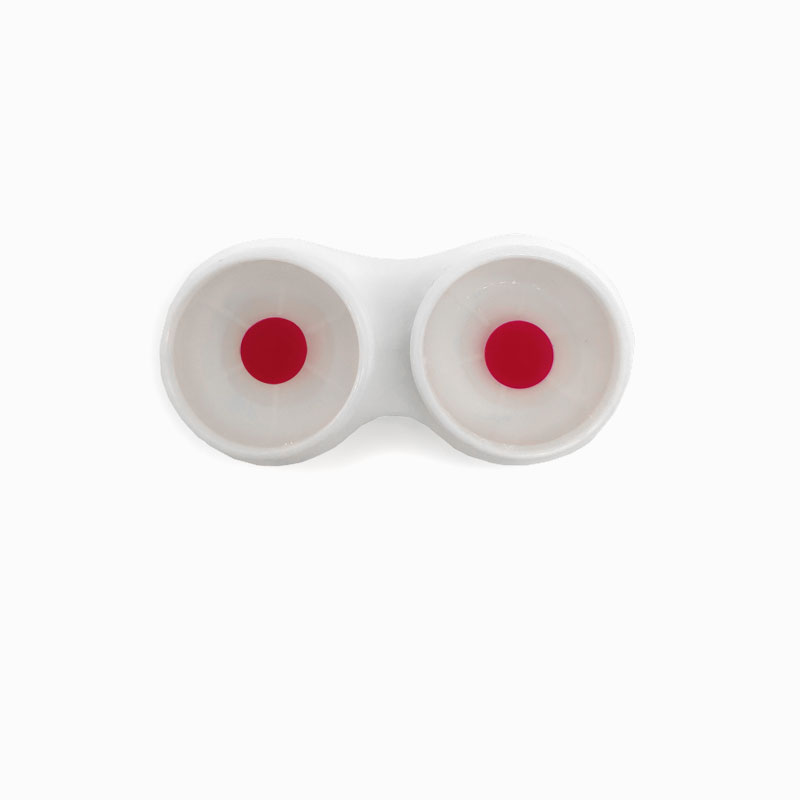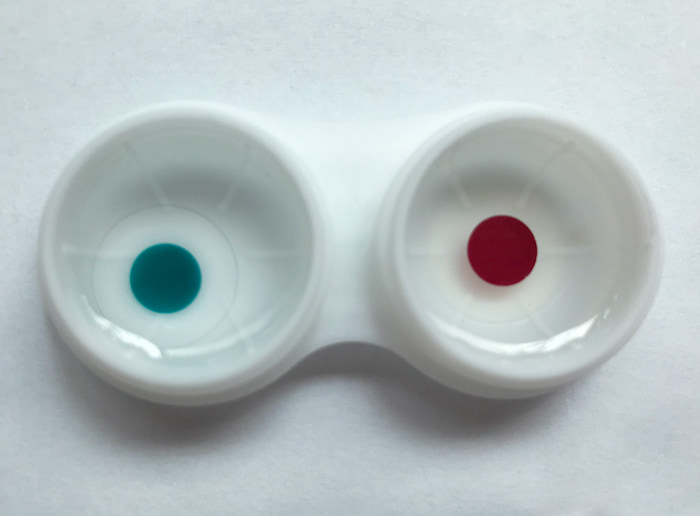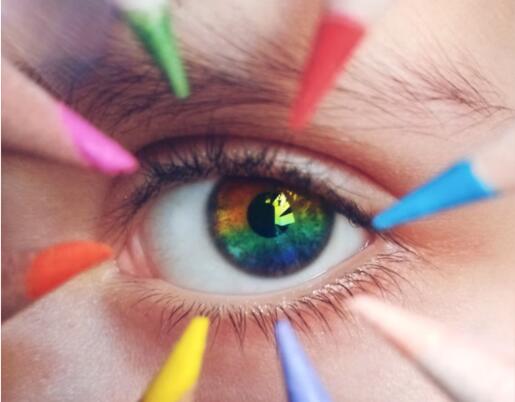Color blindness is also called color vision deficiency. It is the decreased or complete inability to see color differences that others can see. It affects a significant portion of the population, with around 1 in 12 men and 1 in 200 women having some form of color blindness.
People with color blindness struggle to tell certain colors apart. This problem most often affects red, green, blue, yellow, pink, orange, purple, and brown. This can make everyday activities harder. It affects choosing clothing, reading maps and graphs, driving, sports, and cooking. Some careers rely heavily on color perception. These include electricians, designers, photographers, and pilots. They can be especially difficult for those with color blindness.
The most common cause of color blindness is a genetic mutation. This mutation prevents or alters the normal function of cone cells in our eyes. Cone cells detect color. Other causes include disease, trauma, side effects of medication, and aging. There is no cure. But, some adaptive tools, like color contacts, filters, and aids, can help the color blind. They help them navigate a colorful world.
This article will look at color blind contact lenses. It will review the top brands and see how well they improve color perception for the color blind. We’ll cover what to look for when picking contacts. We’ll also cover trying them on for the first time, expected results, care, and what future innovations may come. The goal is to provide a helpful and comprehensive guide to this emerging assistive technology for the color blind community.
Types of color blind
There are 3 main types of color blindness:
Red-Green Color Blindness
This is the most common type, affecting around 1 in 12 men and 1 in 200 women globally. People with red-green color blindness struggle to tell reds from greens, browns, and oranges. These colors may appear faded, dull, or indistinguishable from each other. This is usually caused by an abnormality in the red or green retinal cone cells.
Blue-Yellow Color Blindness
This type affects blue and yellow perception. It is much rarer, impacting just 1 in 10,000 people worldwide. People with blue-yellow color blindness struggle to spot differences. They struggle with blues, yellows, greens, and violets. This is caused by missing or faulty blue retinal cone cells.
Complete Color Blindness
Also known as monochromacy or achromatopsia, complete color blindness is extremely rare. It affects around 1 in 33,000 people worldwide. Those with complete color blindness can only see shades of black, white and gray, as they lack functioning cone cells. This condition is usually present from birth.
Red-green blindness is divided into 2 types
Protonomaly-This type of color blindness is less sensitive to red light and causes the affected person to be indistinguishable from the same color in the red-green-yellow spectrum
Deutranomaly-reduced sensitivity to green light and is the most common form of colour blindness.
Protanopia –people may confuse:
- Black with many shades of red
- Dark brown with dark green, dark orange and dark red
- Some blues with some reds, purples and dark pinks
- Mid-greens with some oranges
Deuteranopes–people may confuse:
- Mid-reds with mid-greens
- Blue-greens with grey and mid-pinks
- Bright greens with yellows
- Pale pinks with light grey
- Mid-reds with mid-brown
- Light blues with lilac
Tritanopes–most people confuse: light blues with greys, dark purples with black, mid-greens with blues and oranges with reds.
Monochromacy — can see no colour at all and their world like only seeing the world on an old black and white television set.
Challenges of Color Blindness
Color blindness presents various challenges in daily life. The most obvious issue is the inability to distinguish between certain colors properly. For example, people with red-green color blindness may confuse red and green. Or, they may see them as duller, less vibrant versions of how they appear to people with normal color vision. This can make some tasks harder. For example, reading colored text, seeing traffic lights, picking clothes, and spotting ripe fruit.
Color blindness also affects depth perception and contrast. It makes it harder to judge distances or see objects clearly against their background. Certain hues like purple may appear dark and murky. This can hurt art appreciation. It also impacts photography, graphic design, and data analysis with colored charts.
In professional settings, challenges can arise for jobs. These include electricians, pilots, scientists, and designers. These jobs rely heavily on color coding and differentiation. In conversations, those with color blindness may not see blushing, paleness, or other skin color changes. These changes give social cues.
Overall, color blindness presents frustrations and difficulties in tasks most take for granted. It can reduce visual accuracy and enjoyment of the vibrant world of color most perceive. Those affected must find ways to adapt and compensate.
Do Color Blind Contacts Work?
Color blind contacts work by using special tinted filters to change the wavelengths of light that reach the retina. This makes colors look more different. It helps people with color blindness.
There are two main ways that color blind contacts achieve this:
Filtering out overlapping wavelengths
The most common types of color blindness are red-green color blindness. People with it struggle to tell reds, greens, and their mixes apart. This is because the light for these colors stimulates overlapping receptors.
Color blind contacts use a filter to block some light. It blocks some of the overlapping wavelengths. This increases the difference between light signals going to the red and green photoreceptors.
For example, lenses may filter out some medium greens. These greens normally overstimulate red receptors. This makes it easier to tell red and green apart.
Boosting weaker color signals
Some contacts also enhance certain wavelengths to boost weaker color signals.
For people with blue color blindness, the signal from blue light to blue photoreceptors is weaker. Special filters can amplify blue light to make these colors more vivid.
By changing the passing wavelengths, color blind contacts can reshape how a color vision deficient person sees. They make it more in line with normal color vision. The brain learns to interpret the enhanced visual input, allowing people to better distinguish colors.
Treatment of color blindness
Researchers at the University of Hong Kong have developed a nano-coating material and process. They can use it in contact lenses to fix color vision.
This material works by blocking the band between red and green light. It also boosts red and green light. This helps to better tell red from green.
People with red and green defects use this kind of lens. After 1-3 weeks, look at the numbers and the environment. The clarity of the colors or numbers has greatly improved.
As a result, this nano-coated lens can improve the color vision of people with color blindness.
Color blind contacts will make your life easier. Get the right contact lense that really fits you! For example, read newspapers without any problem when everything is green. And, enjoy a beautiful landscape painting without any confusion on different shades of green. Imagine enjoying watching all kinds of sports in which color plays an important role like basketball or soccer. You will be able to identify specific objects, such as enemy aircraft or friendly aircraft. Also, you can easily match uniform colors you are issued by your company or by your state department.
Best Color Blind Contacts in 2024
1.ColorKinds Color Blind Contacts
ColorKinds color blind contacts uses the research and development results of the University of Hong Kong. Now, after many red-green blind patients in Southeast Asia and Hong Kong, it is proven that these nano-coated color blind contact lenses greatly improve their color vision. They have brought hope to their lives.



ColorKinds color vision contacts lenses are currently the third generation of contact color blind lenses, using the latest nanotechnology.
which only passes through the 590 to 700nm (nanometer) incident light spectrum, improves the ability to distinguish patients with weak red/green/blue.
Specification:
- Material : 62% Polymacon
- Diameter : 13.6 mm
- Water Content : 40%
- Oxygen Transmissibility : 147
- Base Curve : 8.6 mm
- Using Period : 6-12 months
Pros:
There are a large number of customers in Southeast Asia and China. The product is mature and the recognition rate of red-green blindness is very high.,Shipping worldwide by free.provider 1 year warranty.Unit Pirce $99 Only,affordable cost worthy to buy.
Cons:
Free shipping may take long time to delivery due to covid-19 issue conditions.
2.Queencontacts color blind contacts
The Queencontacts company makes colorblind contact lenses. It has many customers in Europe and Korea. They have developed a dye that can be put on contact lenses to fix color vision. This dye works by blocking the band between red and green light. This helps people see the difference between red and green.

PROS:
Has a large number of customers in Europe and South Korea, with mature technology, has its own team for product research and development, and will make improvements and develop new products.
CONS:
Unit Pirce $299.Not offer free shipping.If you are not sensitive to price, you can buy and try.
3.ColorCorrection System by colormax
Dr. Thomas Azman invented the ColorCorrection System™. It uses filters to change the color wavelengths that enter your eyes. These filters are designed for everyone and can be designed as color blind glasses or color blind contact lenses (color blind contact lenses).
PROS:
Customized color correction lenses that will allow you to see a whole new world of colors and ensure that you pass the Ishihara color palette test.
CONS:
No onlinle sale.need contact Dr Thomas Azman by offline.
What to Look for When Buying
When looking to purchase color blind contact lenses, there are a few key factors to consider:
- Doctor Recommendation – It’s important to consult with your eye doctor before trying color blind contacts. Your doctor can evaluate your vision needs and determine if these specialized contacts are right for you. They can also provide guidance on reputable brands and prescription strengths to look for.
- Comfort – As with any contacts, comfort is paramount. Look for color blind contacts made from breathable, durable materials. Rigid gas permeable (RGP) or hybrid lenses tend to be quite comfortable for long-term wear. Softer disposable options may work better for shorter durations.
- Pricing – Costs can range widely for color blind contacts, from $100-$400 or more for a yearly supply. More advanced designs and customization may come at a higher price. Check if your vision insurance provides any coverage. Also look for bundled packages or discounts when buying multiple pairs.
Prioritize doctor approval, comfort, and affordable pricing. This will help you select effective color blind contacts. They will be tailored to your eyes and budget. Be wary of extremely cheap lenses, as quality is important when it comes to medical devices for your eyes. Investing in the right contacts makes it more likely you’ll wear them consistently and see benefits.
Trying Them On
Trying color blind contact lenses for the first time can feel strange and take some adjustment. Here are some tips for your first time trying on color blind contacts:
- Make sure to have clean hands and start with clean lenses before handling them. Follow the detailed instructions from the manufacturer on proper handling.
- Put the contacts in one at a time. It may help to start with your dominant eye first. Gently place the contact directly on your eye. Don’t rub your eyes after insertion.
- Give your eyes time to adjust after putting the contacts in. It may feel uncomfortable or blurry at first. Blink normally and allow 15-30 minutes for your eyes to settle with the contacts. Don’t try to remove them right away if they feel odd.
- Practice inserting and removing the contacts prior to wearing them all day. Try wearing them for just 30 minutes to an hour at first. Slowly increase wear time as your eyes adjust to having contacts in.
- Use eye drops like rewetting drops if the contacts make your eyes feel dry. Don’t use eye drops that contain steroids or antihistamines.
- Avoid wearing makeup or lotions around the eyes until you’re comfortable handling the contacts to avoid irritation or infection.
- Don’t sleep in the color blind contacts at first. Always remove them before napping or sleeping until you’re used to the feel.
With patience and practice, you’ll adjust to wearing color blind contact lenses. Take it slow at first and consult your eye doctor with any concerns. The adjustment period is worth it for the gift of color vision.
Results to Expect
The results from using color blind contact lenses can vary from person to person. However, most users report a slow improvement. They get better at distinguishing colors while wearing the contacts.
The contacts work by filtering out certain wavelengths of light that cause confusion for color blind people. This helps enhance the contrast between colors that are commonly mixed up, like reds and greens or blues and purples.
Many people find they are able to see more vibrant versions of colors while wearing the contacts. Reds may appear richer and greens can look more emerald. Having an expanded range of detectable colors opens up a new visual experience.
Wearing the contacts allows people to pass the Ishihara color blindness test. Before, passing the test was impossible for them. This test uses dot patterns in shades of red and green that are invisible to color blind people. Being able to see these patterns is a clear indication that the contacts are working.
Over time, some users report that their brain learns to distinguish colors better, even when not wearing the contacts. It’s like getting a new eyeglass prescription. At first, vision is much better with the glasses. But, over time, the brain adapts to interpret visual information better.
However, most color blind people still need the contacts to see colors normally. The level of correction depends on the type and severity of color blindness. The contacts provide an assistive filter that enables new color perception.
The improvement in color vision can have a significant impact on daily life. It becomes easier to recognize traffic lights. It also gets easier to read charts and graphs, pick clothing colors, and see the vibrancy of nature. While not a cure, color blind contacts offer practical enhancements by expanding the range of visible colors.
Maintenance Tips
Properly caring for your color blind contact lenses is crucial for comfort, vision, and longevity. Here are some key maintenance tips:
- Clean properly. Follow the manufacturer’s instructions for cleaning solutions and frequency. Rubbing and rinsing removes protein buildup and debris.
- Avoid damage. Don’t sleep in lenses overnight unless approved. Don’t shower, swim, or expose them to water without goggles. Avoid rubbing eyes.
- Replace on schedule. Don’t overwear disposable lenses beyond the prescription. Reusable lenses have a more limited lifespan.
- Store correctly. Disinfect, dry, and keep lenses in the proper case when not being worn. Don’t mix up right and left lenses.
- Lubricate. Use rewetting drops as needed for comfort. Avoid wearing lenses too long if they feel dry.
- Check for problems. Remove lenses if any pain, irritation, redness or changes in vision occur. Consult an eye doctor for guidance.
- Handle carefully. Don’t drop lenses or handle them with dirty hands. Carefully insert and remove according to directions.
Proper lens hygiene and care makes a big difference in having a successful experience with color blind contact lenses. Taking steps to keep lenses clean and undamaged will help them work their best.
The Future of Color Blind Contacts
There is room for improvement and continued progress when it comes to color blind contact lenses. Research is ongoing to further enhance the technology and provide even better results for those with color vision deficiencies.
Some key areas researchers are focusing on include:
- Expanding the range of color vision that the contacts can correct. Current lenses mainly address red-green color blindness, but future versions may also help with blue-yellow color deficiencies.
- Improving comfort and breathability. As with any contacts, comfort is important for long-term wear. New materials and coatings could make color blind contacts feel more natural in the eyes.
- Increasing durability. The goal is to make color blind contacts capable of daily wear for multiple years before needing replacement.
- Developing adaptive lenses. These contacts could automatically adjust based on the wearer’s individual color blindness severity and type.
- Enhancing natural appearance. There is work being done to fine-tune the optics and make the color enhancement effect blend even more seamlessly.
- Reducing cost. Prices should become more affordable as manufacturing scales up and new technologies emerge.
- Expanding access. Color blind contacts may become available in more locations, especially as online eyeglasses retailers start offering them.
Continued innovation in color blind assistive devices and treatments provides hope for the color vision deficient community. While contacts already work well today, the future looks even brighter.

